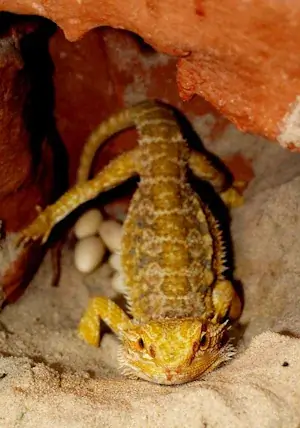A Comprehensive Guide to Incubating Bearded Dragon Eggs
Breeding bearded dragons is a fascinating and rewarding experience that requires careful preparation and patience. Incubating their eggs is a crucial step in this process. In this article, you’ll learn everything you need to know about incubating bearded dragon eggs—from egg-laying to the hatching of baby dragons.
1. Preparation Before Egg-Laying
Before egg-laying begins, you need to establish the basics for successful breeding:
1.1 Mating and Pregnancy
- Bearded dragons reach sexual maturity at around 18 months.
- After successful mating, the female will be pregnant for 3–6 weeks.
- During this period, provide the female with calcium-rich food and UVB light to support the development of the eggshells.
1.2 Egg-Laying Area in the Terrarium
Prepare a laying box:
- Use a plastic box filled with a mixture of moist sand and soil.
- Ensure the box is at least 20 cm (8 inches) deep to allow the female to bury her eggs.
- Maintain the temperature near the egg-laying area at around 28–30 °C (82–86 °F).
1.3 Signs of Egg-Laying
- The female will become restless and start digging.
- She may eat less and search for a suitable place to lay her eggs.
2. Collecting the Eggs
2.1 Handling with Care
- Gently dig up the eggs after the female has buried them.
- Do not turn the eggs! The embryo is already fixed in position.
2.2 Transporting to the Incubator
- Place the eggs on a moist paper towel or directly in the prepared incubator.
- Avoid shaking or jostling the eggs during transport.
3. The Incubator: A Must-Have for Breeding
An incubator is essential for creating the optimal conditions needed to hatch the eggs successfully.
3.1 Setting Up the Incubator
- Container: Use a plastic box with a lid.
- Substrate: Choose vermiculite or perlite, as they retain moisture well.
- Mixing Ratio: 1 part water to 1 part substrate by weight.
3.2 Temperature and Humidity
- Keep the temperature stable at 28–30 °C (82–86 °F).
- Maintain humidity at 75–85%.
- Regularly check conditions with a thermometer and hygrometer.
3.3 Placing the Eggs
- Place the eggs on the substrate without covering them.
- Ensure the eggs do not touch each other to prevent mold growth.
4. The Incubation Period
4.1 How Long Does Incubation Take?
- The incubation period is 55–75 days, depending on the temperature.
4.2 Regular Monitoring
- Check humidity and temperature daily.
- Remove moldy eggs immediately to protect the others.
4.3 Egg Development
- Healthy eggs remain plump and can be candled (illuminated with a light) after a few weeks.
- When candled, you’ll see blood vessels and, later, the embryo inside.
5. The Hatching Process
5.1 Signs of Hatching
- Shortly before hatching, the shell becomes slightly discolored and thinner.
- The hatchlings break the shell using a special egg tooth.
5.2 Assisting Hatchlings
- Do not intervene unless a hatchling is in distress and unable to free itself.
- The hatching process can take several hours to a day.
5.3 After Hatching
- Leave the hatchlings in the incubator until their yolk sac is fully absorbed (about 24 hours).
- Then move them to a prepared rearing terrarium.
6. Caring for Hatchlings
6.1 Rearing Terrarium
- Size: At least 80 × 50 × 50 cm (31 × 20 × 20 inches) for up to 10 hatchlings.
- Substrate: Use paper towels or non-toxic sand.
- Temperature: 35–40 °C (95–104 °F) on basking spots, 28–30 °C (82–86 °F) in other areas.
6.2 Feeding Hatchlings
- Offer small insects like fruit flies or tiny crickets.
- Supplement their diet with calcium and vitamin powders.
6.3 Separating Hatchlings
- Monitor their behavior: Dominant hatchlings may intimidate smaller ones.
- Separate aggressive individuals to prevent injuries.
7. Common Problems and Solutions
7.1 Mold
- Cause: High humidity or contact with moldy eggs.
- Solution: Remove affected eggs and adjust conditions.
7.2 Infertile Eggs
- Infertile eggs won’t develop and may rot.
- Identify them early through candling.
7.3 Temperature Issues
- High temperatures can cause deformities, while low temperatures extend the incubation period.
- Use reliable thermometers and ensure the incubator runs stably.
8. Conclusion: Successful Bearded Dragon Breeding
Incubating bearded dragon eggs is an exciting endeavor that requires careful planning and attention. With the right equipment, optimal conditions, and dedicated care, you can successfully raise healthy hatchlings and contribute to preserving the fascinating world of bearded dragons.

